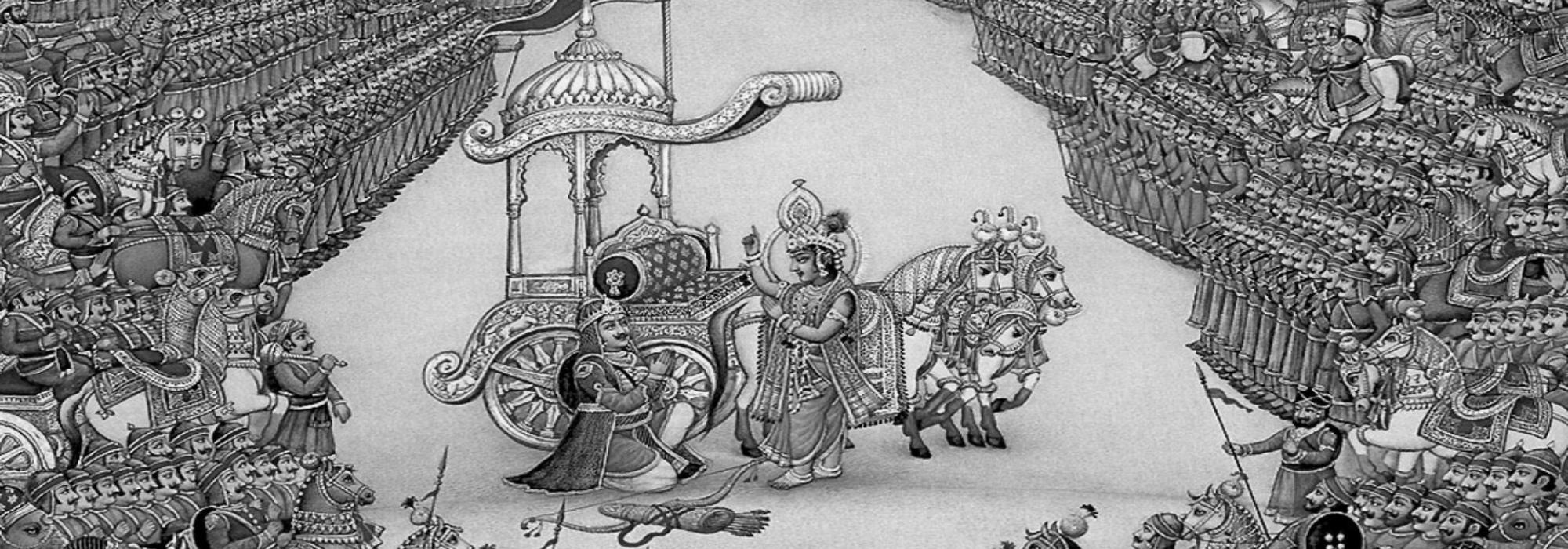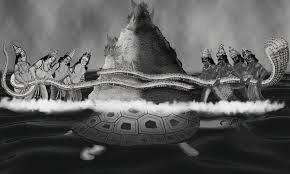The Timeline of the Composition of Mahābhārata
For over a century, scholars from Germany, France, England, and India have extensively studied the Mahābhārata and concluded that it is not the work of a single author composed in a single lifetime. This doesn’t mean, however, that they concur in their views about the authorship and the timeline. It is unnecessary for our present purpose to discuss the divergence of their opinions and the details of their research. The differences in views regarding the timeline of the composition of the epic are so varied that it is impossible to give a rough estimate with an error factor of even a hundred years. The most recent estimate that most scholars seem to agree with is by Dr. M Winternitz, who places it between 400 BCE and 400 CE – a window of eight hundred years! This means that over the past thousand five hundred years or so, it has taken the shape as we see it today. The seed of the story, i.e. the battle between the Kauravas and Pāṇḍavas would have taken place before 400 BCE in that case. In Macdonell’s opinion, the war could not have taken place later than 1000 BCE.
The Composer of the Mahābhārata
We learn these facts about the author Vyāsa from the epic itself. He was born to Sage Parāśara—the son of Śakti—and the maiden Kālī [i.e. Satyavatī, before she married Śāntanu] in an island of the river Yamunā. Immediately following his birth, he grew up to be an intelligent young man with expertise in Vedas, Vedāṅgas, and Itihāsas. There was none to better him at tapas, the study of Vedas, and following rituals. He organized the Vedas into four. He was a brahmaṛṣi, a poet, a man of high integrity, and noble in conduct. In deference to his mother’s wish, he was responsible for the birth of Dhṛtarāṣṭra, Pāṇḍu, and Vidura [through niyoga] thus helping the continuance of Śantanu’s lineage. While King Janamejaya was performing the yajña, Vyāsa went there with his disciples. Janamejaya wished to listen to the exploits of the Kauravas and Pāṇḍavas that Vyāsa had witnessed with his own eyes. Vyāsa directed his disciple Vaiśampāyana to narrate the story exactly the way he had heard it from his guru [i.e. Vyāsa]. Since he was born on an island, Vyāsa came to be called Dvaipāyana [dvīpa = island] and as he was dark-complexioned, he came to be called Kṛṣṇa [kṛṣṇa = dark]. He composed the epic after he had organized the Vedas. He narrated the epic Bhārata after the deaths of Dhṛtarāṣṭra, Pāṇḍu, and Vidura. [Ādiparva adhyāyas 1, 54, 57, and 99.]
According to some Western critics, Vyāsa was a fictional character; the author of the Bhārata is unknown; a great poet probably compiled the courageous story of the Kauravas and Pāṇḍavas, which was popular in the oral tradition, and this became the basis of the epic. Well, let us give the name Vyāsa to that great poet, who is apparently anonymous! Until we have established without doubt the real identity of this poet, let us continue to call him Vyāsa! The modern people find it hard to believe that a single person could do all that Sage Vyāsa, of infinite brilliance, is supposed to have done; he was born on an island, grew up instantly, acquired mastery over several arts and śāstras, organized the Vedas, composed the Mahābhārata apart from the eighteen Purāṇas and eighteen Upapurāṇas, and lived an immensely long life [or is ‘immortal’, as the legend goes]. Even in the past, some were skeptical about such tall claims. The Devī-bhāgavata, Viṣṇu-purāṇa, and other works opine that Vyāsa was not a single person but there were twenty-seven people with the same name. These Purāṇas, however, do not clarify which Vyāsa composed what work.
[Translator's Note: It must be noted that since A R Krishna Sastri's time, i.e. in the past 60-70 years, there has been a great deal of research on the timeline of the Mahabharata and its composition as well as the composer. We know today that the events of the Mahabharata as well as the composition (of the extant text) are much older than was believed earlier. We can also say with much more confidence today that the core verses of the Mahabharata (at least 50,000 of the 82,000-odd verses in the critical text prepared under the editorship of V S Sukhthankar) were composed by a single author, whom our tradition as hailed as Bhagavān Veda-vyāsa.]
Mahābhārata: Itihāsa-Purāṇa-Ākhyāna
If the Mahābhārata is classified as an ‘itihāsa,’ it suggests that it is a ‘historical text.’ [The word ‘itihāsa’ comes from iti+ha+āsa, meaning ‘it happened so.’] But it is not ‘history’ in the sense that we understand it today. In Kautilya’s Arthaśāstra, he defines itihāsa as follows:
पुराणमितिवृत्तमाख्यायिकोदाहरणं धर्मशास्त्रमर्थशास्त्रं चेदितिहासः । (1.5)
Thus Itihāsa is an all-encompassing term that includes Purāṇas (mythical episodes), history, stories, anecdotes, as well as principles of dharma (sustainability principles) and artha (material means to fulfill desires). This definition is largely applicable to the extant text of the Mahābhārata. It is both a Purāṇa and a dharmaśāstra.
· ‘Purāṇa’ refers to something that is ancient; it is older than history; it is something that nobody has seen; it isonly heard from times immemorial. For example, it includes the stories of creation, samudra-mathana (the churning of the mythical ocean), and the killing of Vṛtrāsura (by Indra).
· ‘Ākhyāna’ refers to something that is narrated, i.e. a ‘tale.’
· ‘Upākhyāna’ refers to a sub-plot in the main story. For instance, the Nalopākhyāna [the tale of Nala-Damayanti], Sāvitryopākhyāna [the story of Sāvitrī-Satyavān], and Dharmavyādhopākhyāna [the episode of Dharmavyādha].
Therefore, the Mahābhārata is both an itihāsa and an ākhyāna. Six ślokas have been previously quoted from the second adhyāya of the Ādiparva where the Mahābhārata is once referred to as ‘itihāsa’ and referred to as ‘ākhyāna’ five times. It is also referred to as an ‘upākhyāna’ in śloka 2.236, but it is inappropriate to use the term ‘upākhyāna’ for the epic since we will have to then show the ākhyāna that encompasses this upākhyāna.
‘Purāṇa’ is typically defined as
सर्गश्च प्रतिसर्गश्च
वंशो मन्वन्तराणि च ।
वंशानुचरितं चेति
पुराणं पञ्चलक्षणम् ॥
The five qualities that a Purāṇa must have are: i. Sarga (creation), ii. Pratisarga (secondary creation or re-creation), iii. Vaṃśa (lineage of deities, seers, and kings), iv. Manvantara (time-spans, epochs), and v. Vaṃśānucaritam (the stories of the lineages). All these are indeed contained in the epic. See the following śloka, quoted earlier as well:
अस्याख्यानस्य विषये पुराणं वर्तते द्विजाः ।
अन्तरिक्षस्य विषये प्रजा इव चतुर्विधाः ॥ २३८
Just as the four kinds of beings are contained in space, all the Purāṇas are contained in this great epic.
It is probably for this reason that works such as the Mahābhārata and other ākhyānas were classified under ‘Itihāsa-Purāṇa.’ [इतिहासपुराणं पुष्पं इतिहासपुराणः पञ्चमो वेदानां — Chāndogya Upaniṣad 3.4.1, 7.1.4] But what we see primarily in the Purāṇas is the greatness of Brahma, Viṣṇu, Śiva and other deities; and in the Itihāsas, it is the deeds of courageous heroes. However, in sum, Itihāsas are older than Purāṇas; the Chāndogya Upaniṣad [नाम वा ऋग्वेदो यजुर्वेदः सामवेद अथर्वणश्चतुर्थ इतिहास पुराणः पञ्चमो वेदानां… 7.1.14] and the Arthaśāstra [सामर्ग्यजुर्वेदास्त्रयस्त्रयी
















































